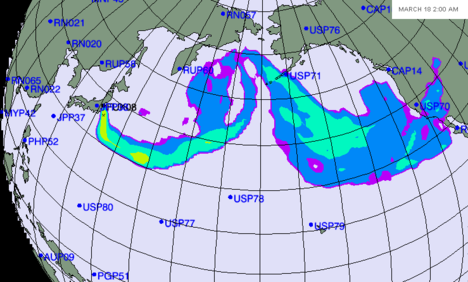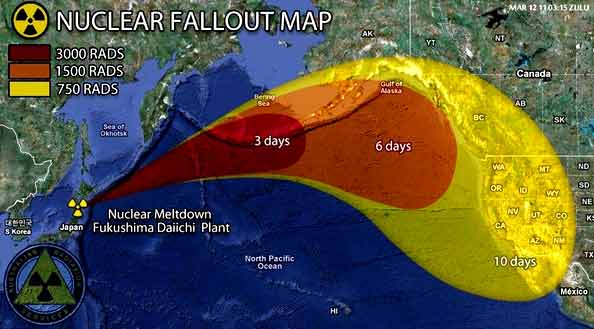The Medical Implications of the 2011 Fukushima Nuclear Disaster

The following article award winning author and Co-founder of Physicians for Social responsibility Dr. Helen Caldicott proceeds to examine the medical implications of the ongoing Fukushima crisis.
For her analysis on Chernobyl see:
The Medical Implications of the 1986 Chernobyl Nuclear Disaster By Helen Caldicott, April 25, 2016.
It has been estimated by the authors of the Chernobyl report that by the year 2009, 23 years after the accident, some one million people had died.
The people in Japan were lucky in that 80% of the radiation resulting from the March 2011 Fukushima disaster blew across the Pacific Ocean in the first few days of the accident. The wind then changed and blew the radioactive plumes over the north west of Japan and south to Tokyo.
Large numbers of people were and still are exposed to high levels of radiation, both from external gamma rays beaming from radioactive elements on the ground, as well as internal doses from elements breathed into the lungs and incorporated into food.
Disinformation
In terms of the medical effects of Fukushima there is a cone of silence that has been placed over the release of documented data related to patients and their associated illnesses. In fact a report noted that many doctors have been ordered not to inform their patients that their symptoms could be related to radiation. This leaves the population and in particular the parents in a state of despair. They need to know the truth about their situation and that of their children.
In Fukushima Prefecture, it was the prefectural government that entered into an agreement with IAEA in the area of decontamination and radioactive waste management, whereas Fukushima Medical University entered into an agreement with IAEA in the area of the survey of radiological effect on human health. […] “The Parties will ensure the confidentiality of information classified by the other Party as restricted or confidential.” […] if either the prefectures or IAEA decide to classify information for “they contribute to worsening of the residents’ anxiety,” there is a possibility that such information as the accident information, as well as radiation measurement data and thyroid cancer information may not be publicized. […] IAEA has published reports, after the Chernobyl nuclear accident, stating “there were no health effects due to radiation exposure.” […] Tokyo Shimbum Dec 31, 1014
It is obvious that there is collaboration between the WHO and the IAEA and also the Japanese government and the “nuclear village” to hide, to lie and to cover-up vital medical information that must be made available to the Japanese population. The IAEA has also set up an office in Fukushima, and TEPCO and the Japanese government are constructing a large cancer hospital in Fukushima.
To make the situation worse about release of data relating to the accident, Prime Minister Abe has passed a secrecy law which will almost certainly intimidate the media from keeping a very close watch over the tenuous plant.
Radioactive Releases
What is known is that three times more noble gases escaped from the Fukushima accident than at Chernobyl. These gases, xenon, krypton and argon are inhaled into the lungs, are absorbed and deposited in fatty tissue of the body.
They are very high energy gamma emitters – like X rays, and they can therefore cause lung cancer, and cancers of other organs of the body.
It is also been estimated that about the same amount of cesium was released from Fukushima as at Chernobyl.
So based on the number of mortalities and illnesses in the countries around Chernobyl which were not as densely populated as Japan, and considering the very high density of the Japanese population, one would have to assume that similar morbidities and mortalities would occur in Japan over the coming decades.
Thyroid Cancer
Already of the 270,000 Fukushima children under the age of 18 examined for thyroid cancer a total of 75 have suspected or are confirmed to have thyroid cancer. The official line is that these cancers could not possibly be related to radiation because of the short incubation time of 2-3 years, however this correlates with the Chernobyl data which demonstrated early thyroid cancer presentation.
Fish
The situation at the Fukushima Daichi plant gets worse by the day. 400 tons of very radioactive water have been discharged to the Pacific ocean on a daily basis ever since the accident causing fish to concentrate the radioactive elements in their flesh and bones. Some fish have been found to carry extremely high radiation levels – 12,400 Bc/K when the limit for food in Japan is 100 Bc/k. Of course no radiation is safe and the more radioactive food that is eaten the more these elements accumulate in bodily organs increasing the radiation dose. Some fresh water fish have also been found to be very radioactive, for instance 2657 Bc/k in a fish from the Mono River in NW Fukushima.
The fishermen are very concerned about the ongoing oceanic releases as well as the fact that TEPCO is considering discharging the very radioactive water it is currently storing in temporary tanks, after it has been “filtered” for many isotopes. Previous attempts have failed, and this new equipment, ARM from the US will almost certainly not remove the many isotopes before discharge. In particular tritium cannot be filtered, it accumulates in the food chain, and it causes brain tumors, congenital malformations, and many other cancers and it remains radioactive for 120 years.
Remedial Situation
As hundreds of tons of water pour down from the mountain behind the Fukushima reactors complex, it then travels beneath the damaged reactors becoming radioactive as it mixes with the three molten cores. TECO now plans to pump this mountain water before it enters the reactor area and divert it to the sea. However this technique will only suck more of the radiation beneath the reactors to mix with mountain water which will make the situation worse.
Recently TEPCO announced that it had been wrong about the measurements of strontium 90 being found in the water in various wells near the reactors and that the measurements last June, 2013 were actually 5 times higher than they originally announced and are now at 5 million Bc/liter. One wonders whether TEPCO covered up these findings so that the Olympic Committee would choose Tokyo for the games.
Much of the reactor complex now stands on liquefied mud. The buildings of unit 3 and 4 were quite severely structurally damaged by the initial earthquake. In the event of an earthquake greater than 7 on the Richter scale it is predicted that either one or both of these building could collapse. Unit 4 would plunge to the ground along with its cooling pool containing over 200 tons of extremely radioactive fuel. This fuel would then spontaneously ignite releasing 10 times more cesium than was released at Chernobyl. Such a catastrophe would severely pollute much of Japan including Tokyo and the northern hemisphere. It will take TEPCO more than 14 months to remove these fuel bundles from the pool and they are doing it manually instead of by computer control. This is a very delicate procedure and there is a possibility of rods breaking releasing radiation causing the workers to evacuate, or a fission reaction to occur which would also lead to evacuation.
An earthquake beneath unit 3 could also cause the building to collapse onto the molten core releasing huge amounts of radiation. Another earthquake could rupture over 1000 fragile metal tanks now holding thousands of tons of highly radioactive water which would drain into the Pacific Ocean.
Radioactive wastes are being carted around Japan and incinerated thus exporting radiation to other prefectures and cities, while the ashes are being dumped in Tokyo Bay where the athletes will swim during the 2020 Olympics.
Considering all these dangerous events that are now occurring and could occur in the future it would seem extremely unwise for young fit athletes who have trained so assiduously be exposed to any radiation at all. It is a dangerous situation to contemplate.
Workers
Workers who are engaged at unit 4 to remove spent fuel rods from the pool are receiving high doses of radiation according to TEPCO so TECPO is contemplating putting lead plates between the men and the pool. It is true that the workers at the plant are not adequately monitored nor are their radiation records carefully kept, nor their health routinely examined and medical records monitored. We know what happened to the liquidators at Chernobyl and almost certainly similar illness will pervade the Fukushima workers, some of whom are homeless men recruited by the Yakuza.
General Population
13% of the Japanese mainland is now contaminated with radioactive elements which will last for hundreds to thousands of years and will be concentrated in the food. Ten million people live in highly radioactive areas, so much so that the government has raised the accepted dose from 1 mS per year to 20 mS per year (which is the equivalent of 1000 chest X rays /year) – nuclear workers are allowed 50mS per year. Children are 10 to 20 times more sensitive to radiation effects than adults. Thousands of children are now locked inside, they wear masks and they are eating radioactive food and experiencing increased obesity as they get virtually no exercise.
The Environment
Dr Timothy Mousseau, an evolutionary biologist has been examining the birds and insects in the exclusion zones of Chernobyl and Fukushima. 40% of the male swallows are sterile or have abnormal sperm, many have tumors, crooked wings and other congenital abnormalities and mutations, many have cataracts and the insects are similarly deformed.
What happens to animals and insects happens to us, but because many generations appear in a year we then can postulate what will happen to future generations of humans as mutations are passed down to our descendants.



